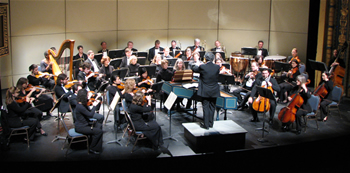The American Dance Festival continues its nearly unparalleled presentation of premieres and nearly new works with Adele Myers and Dancers‘ Einstein’s Happiest Thought. First performed in September, 2013, at Connecticut College, this is a multimedia creation that is a paradox of simplicity and transparency vs. intricacy and psychological depth. This performance at Reynolds Auditorium at Duke University gave the audience the opportunity to decide for themselves the levels of examination they wished to attribute to this hour-long creation.
Unlike many artists who proclaim a vision for their creation and practically insist that the viewer honor that narrative, Adele Myers, choreographer and director, is unique in her realization that once you give creative birth you must let the result go for others to determine what it means to them. This is evident in the program where she writes “What is this dance about? If you want to know the answer read on. If not, skip this part.” She then proceeds to “explain” Einstein’s Happiest Thought.
There is no curtain at Reynolds, so the arriving audience saw the set. The most prominent prop was a very tall and large metal ladder. This became the central physical and psychological obstacle as well as the symbol of personal attainment. At the start we saw a lone woman (Morgan Griffin), dressed in yellow street clothes, slowly emerge stage right holding a taut yellow rope from behind. She is known as “The Walker.” The music began – a pulsating electronic motif – while a man repeatedly intoned, “Here’s another old friend of ours – listen.” Four dancers (Tara Burns, Raphaelle Kessedjian, Kellie Lynch and Amber Morgan) raced across the stage. When they stopped to perform moves that involved balance of any kind, each seemed to be having a very difficult time with what should be elemental dance tasks. This improved as the performance went on. The music was reduced to a blaring repetition that had you screaming inwardly “enough already!” This went on for about fifteen minutes and then, mercifully, stopped. In the meantime, “The Walker” was almost imperceptibly making her way towards her goal which, by now, was obvious to everyone: the huge ladder. While not dancing in the traditional sense of the word, Griffin was masterful in her stillness and her ability to displace distance without bringing any attention to herself. In fact, I was more impressed with her performance than the “real” dancers.
A short film appeared with disparate images of white-haired women walking, snaking power lines, and other gratuitous and unrelated items pointing to the time and space theme of Einstein. The dancers emerged and engaged in much more substantial movement, much of it with a strong gymnastic bent. An unusual aspect, particularly when all four were dancing together, was that one would give audible verbal cues for starting and stopping. When they did stop, they also engaged in an obvious exaggeration of breathing, both in sound and movement of shoulders. Attaining your goal is hard work? “The Walker” kept getting closer and closer. In the meantime, a new character was introduced: let’s call it “baby ladder.” A yellow step-ladder of perhaps four rungs plus two new sets of yellow rope stretched across the stage ratcheted up the possibilities, and the dancers began a series of hippety-hop steps jumping over the new ropes. One dancer partnered with “baby ladder” and had trouble conquering even this small obstacle.
“The Walker” finally reached the large ladder and began her ascent. The dancers celebrated with much joy over this triumph of time, space, and elevation. A dancer not only reached the top of “baby ladder” but performed exemplary feats of balance and splits. Everyone got to the top. The show was over.
I cannot say that there was anything particularly engaging or special with respect to the actual choreography. For the most part, the four dancers were totally independent, and there was little, if any, partnering. For much of the evening, they also appeared to be a bit ragged and struggling. The music, by Josh Quillen, featured mostly a percussion score that grew in intensity and interest as the evening wore on. Lighting and visual design by Kathy Couch greatly enhanced the production.
Miss Myers’ description, alluded to earlier, is rife with exalted ideas about risk, gravity, time, space, narrative, and other concepts. Alternatively, it could also be reduced to someone seeing a challenge/obstacle (big ladder) and slowly proceeding to overcome it while people dance around you celebrating every inch of your progress. After all, as Freud once famously wrote, “sometimes a cigar is just a cigar.”
The company performs again on July 1 and 2. For details, see the sidebar.













